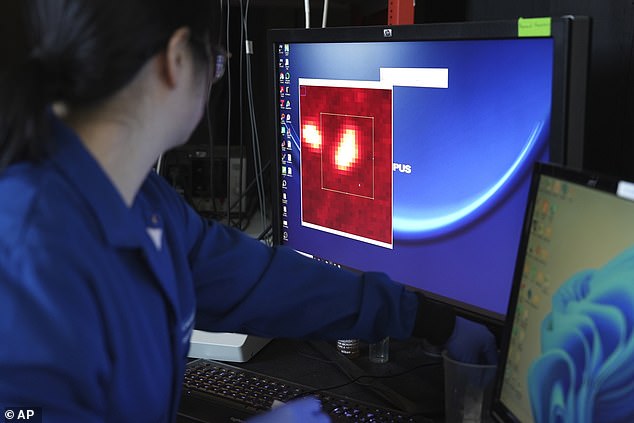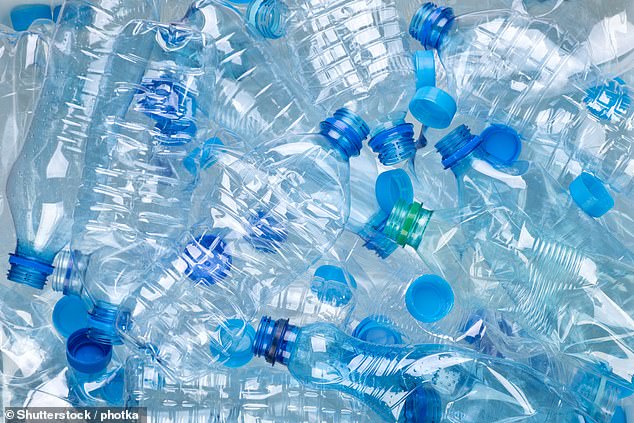Average water bottle contains 240,000 pieces of cancer-causing nanoplastics – 100 times more than previously thought
Plastic water bottles contain hundreds of thousands of floating microscopic plastic particles that have caused cancer, new research has found.
The findings are likely to shock anyone who reaches for a plastic water bottle to quench their thirst.
Drinking water from a bottle could mean you are contaminating your body with tiny pieces of plastic, which scientists fear could build up in your vital organs with unknown health consequences.
Scientists using the most advanced laser scanning techniques found an average of 240,000 plastic particles in a one liter bottle of water, compared to 5.5 per liter of tap water.
Researchers from Columbia University tested three popular brands of bottled water sold in the United States – using lasers to analyze the plastic particles they contained down to a size of just 100 nanometers.

Drinking water from a bottle could mean contaminating your body with tiny bits of plastic, which scientists fear could build up in your vital organs with unknown health consequences.


Scientists using the most advanced laser scanning techniques found an average of 240,000 plastic particles in a one liter bottle of water, compared to 5.5 per liter of tap water
The particles – nanoplastics – are much smaller than the microplastics previously found in bottled water.
But nanoplastics are considered potentially toxic because they are so small that they can go directly into blood cells and the brain.
Nanoplastics contain phthalates – chemicals used to make plastics more durable, flexible and last longer.
Exposure to phthalates is blamed for 100,000 premature deaths annually in the US.
The chemicals are known to disrupt hormone production in the body.
They are “linked to developmental, reproductive, brain, immune and other problems,” according to the National Institute of Environmental Health Sciences.
The highest estimates found 370,000 nanoplastic particles.
Nanoplastics were too difficult to detect with conventional techniques, which could only find microplastics from 5 mm to 1 micrometer – a millionth of a meter, or 1/25,000th of an inch. Nanoplastic particles are smaller than 1 micrometer in diameter.
Groundbreaking research from 2018 found around 300 microplastic particles in a liter of bottled water – but researchers were limited by the measurement techniques used at the time.
Research is now being conducted around the world into the potentially harmful effects of nanoplastics.
Nanoplastics consisted of 90 percent of these particles and 10 percent of microplastics.
A common nanoplastic found was polyethylene terephthalate, or PET.


Using the most advanced laser scanning techniques, scientists have found an average of 240,000 plastic particles in a one-litre plastic bottle of water – thousands of times more particles than previously found
Study co-author Professor Beizhan Yan, an environmental chemist at Columbia, said: “This was not surprising, as many water bottles are made of it,” said
He continues: 'PET is also used for bottled soft drinks, sports drinks and products such as ketchup and mayonnaise.
“It probably ends up in the water because pieces fall off when the bottle is squeezed or exposed to heat.”
Another plastic particle found in water bottles that was much larger than PET was polyamide – a type of nylon.
“Ironically,” said Professor Yan, “this is likely from plastic filters used to supposedly purify the water before it is bottled.”
The other common plastics found were polystyrene, polyvinyl chloride (PVC) and polymethyl methacrylate, all of which are used in various industrial processes.
What the researchers found “troubling,” however, was that these said plastics only made up about 10 percent of all nanoparticles in the samples. They have no idea what the rest is.
Biophysicist and co-author of the study Wei Min said the research opens up a new area in science, adding: 'Previously this was just a dark area, uncharted.
'The study of nanoplastics is important because the smaller things are, the easier they can get into us.'
The team plans to investigate tap water, which has previously been shown to contain microplastics, albeit in much smaller quantities than bottled water.
Globally, plastic production continues to threaten the environment – with 400 million tonnes produced each year.
More than 30 million tonnes are dumped into water or on land every year, and many products made from plastic – such as synthetic clothing – release particles during use.
Experts are still determining the health effects this may have on humans.
